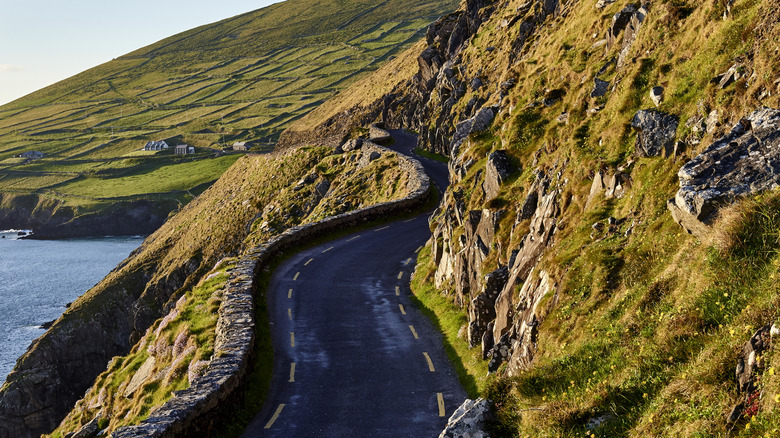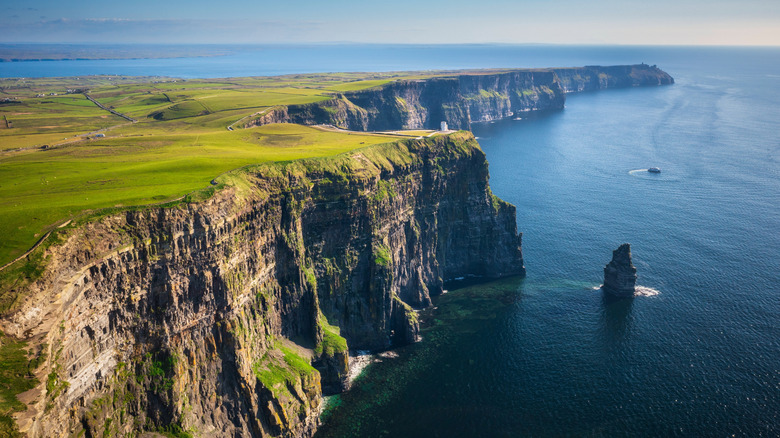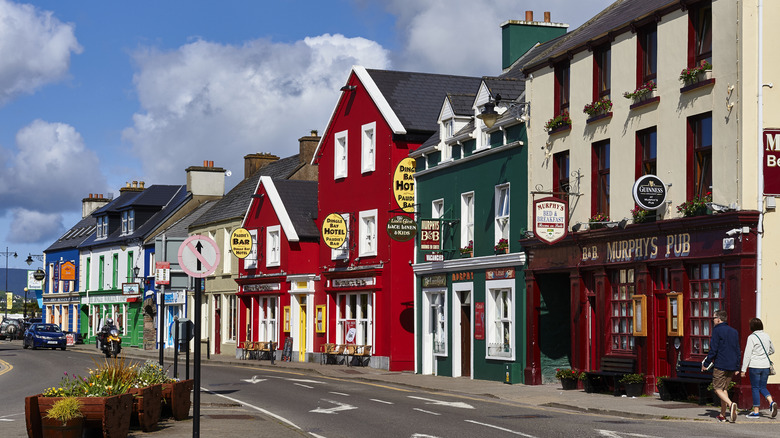One Of The World's 'Longest Defined Coastal Routes' Is An Unforgettable Attraction In Ireland
When it comes to getting deep into a destination, it's hard to beat a good road trip. After all, jumping behind the wheel is one of the best ways to explore the stunning and storied routes available in the U.S., though we sometimes forget that there are other countries that also offer up their splendors via the open road.
Europe has no shortage of places that can be spelunked by automobile, especially the mountains, historic towns, and wine regions of Spain. However, Ireland is also well worth any road trip enthusiast's time. The Emerald Isle won't win any contests for size, but it punches well above its weight when it comes to natural beauty and culture. One of the best ways to experience this is by touring the Wild Atlantic Way.
Snaking along Ireland's wild and raw west coast for some 1,600 miles, this route not only brings visitors face-to-face with the country's splendid natural offerings — including rugged cliffs, lonely beaches, and windswept pastureland — but also allows them to soak up the charm of the towns along the way. With plenty of old-school inns and B&Bs, visitors can take in the Wild Atlantic Way at a leisurely pace, allowing time to sample fresh seafood, catch some traditional music, and savor a splash of whiskey or a dark pint in a cozy pub before setting off to the next destination.
An epic drive on Europe's western edge
Among the longest coastal drives in the world, the Wild Atlantic Way begins in Ireland's deep south at Kinsale Head in County Cork and ends in Donegal in the northwest corner of the Republic. It's divided into a handful of sections that highlight some of western Ireland's most unique features. The entire drive can be made in three to five days, though plenty of people take much longer.
Nature is on offer the whole way, so many travelers break up the drive to get down with some one-of-a-kind outdoor excursions. Western Ireland offers some terrific hiking opportunities, including the 12-mile-long Cliffs of Moher Coastal Walk, the paths through the mountains, heaths, and bogs of Connemara National Park, as well as the trek up and down the 1,969-foot rise of Donegal's Slieve League cliffs. It's also a great place for cycling and, for those willing to brave the northern ocean chill, the towns of Strandhill, Lahinch, and Bundoran are surfing hotspots for both veterans and beginners.
A lot of visitors also stop to visit some of the islands off of Ireland's west coast, including the Skelligs. Rising starkly from the roiling currents of the Atlantic, these wind-blasted rock masses were once home to a monastery and have long held a place in Ireland's collective imagination. Farther north, near the city of Galway, are the Aran Islands, whose dramatic environs are home to some of the country's few populations of Irish speakers. All of these islands can be reached by regular ferry service from the mainland.
A rugged coast of warm hearths and hearts
While the arresting scenery of the Wild Atlantic Way is sure to take your breath away, the towns and settlements along the coast radiate a quaint ambiance and hospitality. These are comfortable, very delicious places with friendly, talkative locals, and the kinds of traditional pubs that Ireland is known world-over for.
Kinsale, Ireland's "Gourmet Capital," is famous for its old forts and amazing seafood, while the picturesque market town of Ennis in County Clare boasts a wealth of live music venues, making it one of the country's top spots to catch a trad jam session. Arty Kenmare in County Kerry has great B&Bs, hotels, spas, and pubs, though the town Dingle, which dates back 6,000 years, just may the crown jewel of the Wild Atlantic Way. Situated on Ireland's far western edge on the peninsula it shares its name with, this bohemian burg has long attracted writers, musicians, and artists, and is surrounded by stunning scenery.
The Wild Atlantic Way also takes drivers through very rural parts of the country. Much of it is a winding, single-laned road, so make sure to take things slowly. Ireland's weather is also notoriously unpredictable, so be sure to pack for the elements, and be prepared for slick and sometimes icy conditions. And for more Celtic coastal exploration, ditch the car and lace up your boots for a breathtaking walk in Wales.


